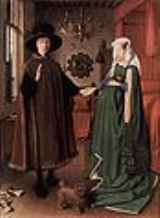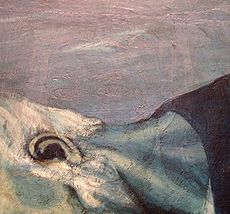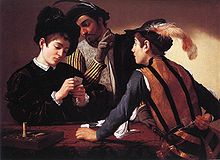
Pentimento
Encyclopedia
A pentimento is an alteration in a painting, evidenced by traces of previous work, showing that the artist has changed his mind as to the composition during the process of painting. The word derives from the Italian
pentirsi, meaning to repent.
, or by the first painted treatment of the element having been over-painted.
Some pentimenti have always been visible on the final painting with careful inspection; others are revealed by the increasing transparency that some paint acquires after several centuries. Others, especially in the underdrawing, can only be seen with modern methods such as X-ray
s and infra-red reflectograms and photographs. These are able to record photographically some pigment
s, depending on their chemical composition, which remain covered by later paint layers. For example white lead
, a common pigment, will be detected by X-ray, and carbon black
underdrawings can often be seen with great clarity in infra-red reflectograms.http://www.clevelandart.org/exhibcef/ConsExhib/html/72881.html These methods have greatly expanded the number of pentimenti art historians are aware of, and confirmed that they are very common in the works of many old master
s, from Jan van Eyck
onwards.
 Pentimenti are considered especially important when considering whether a particular painting is the prime version by the original artist, or a second version by the artist himself, or his workshop, or a later copyist. Normally secondary versions or copies will have few if any pentimenti, although this will not always be the case. See the discussion of this question in the case of The Lute Player
Pentimenti are considered especially important when considering whether a particular painting is the prime version by the original artist, or a second version by the artist himself, or his workshop, or a later copyist. Normally secondary versions or copies will have few if any pentimenti, although this will not always be the case. See the discussion of this question in the case of The Lute Player
by Caravaggio
. Like Rembrandt, Titian
and many other masters, Caravaggio seems rarely to have made preliminary drawings, but to have composed straight onto the canvas. The number of pentimenti found in the work of such masters naturally tends to be higher.
Marks revealing a totally different subject, for example in The Old Guitarist
by Picasso, are not usually described as pentimenti - the artist has abandoned his earlier composition to begin a new one. In cases where a composition has been changed by a later painter or restorer, marks showing the original composition would not be described as pentimenti either - it is necessary that the original painter has changed his mind.
. The distinction between singular and plural is also rather flexible; some writers refer to a change of just one outline as pentimenti, whilst others treat each different area that has been changed as a single pentimento.

 A portrait in the National Gallery, London
A portrait in the National Gallery, London
of Jacques de Norvins by Ingres
was painted in 1811–12 when the sitter was Napoleon's Chief of Police in Rome. Originally, instead of the curtain at the left, there was a fully painted bust of a boy's head on top of a small column. Probably this was a bust of Napoleon's son, who was known as the King of Rome. The presumption is that this was overpainted with the curtain after the fall of Napoleon, either by Ingres himself, or another artist. The bust can just be made out in the enlarged online photo, with its chin level with the sitter's hair-line; the top of the column was level with the middle of the sitter's ear. These may always have been (just) visible, or have become so by the paint becoming transparent with age. Few viewers of the painting would notice the bust without it being pointed out. Strictly speaking, these alterations might not be described as pentimenti, because of the presumed lapse of time, and because another artist may have made the change.http://www.nationalgallery.org.uk/cgi-bin/WebObjects.dll/CollectionPublisher.woa/wa/work?workNumber=ng3291
Another Caravaggio
, The Cardsharps
in the Kimbell Art Museum, Fort Worth has a number of typical minor pentimenti, altering the position of the figure on the right, which are revealed by infra-red reflectograms. These are used in discussing the painting and comparing it to another version of the subject in Bari
.http://www.kimbellart.org/database/conservation.cfm?acquisition_id=AP%201987.06
A Zurbarán in the Cleveland Museum of Art
shows that the size of a white cloth was expanded after the dark background under-paint had been applied; the expanded area is a darker white.http://www.clevelandart.org/exhibcef/ConsExhib/html/zurPent.html
Examples of this were photographed in Amsterdam, 1998.
Italian language
Italian is a Romance language spoken mainly in Europe: Italy, Switzerland, San Marino, Vatican City, by minorities in Malta, Monaco, Croatia, Slovenia, France, Libya, Eritrea, and Somalia, and by immigrant communities in the Americas and Australia...
pentirsi, meaning to repent.
Significance
Pentimenti may show that a composition originally had an element, for example a head or a hand, in a slightly different place, or that an element no longer in the final painting was originally planned. The changes may have been done in the underdrawing of the painting, or by the visible layers of paint differing from the underdrawingUnderdrawing
Underdrawing is the drawing done on a painting ground before paint is applied, for example, an imprimatura or an underpainting. Underdrawing was used extensively by 15th century painters like Jan van Eyck and Rogier van der Weyden. These artists "underdrew" with a brush, using hatching strokes for...
, or by the first painted treatment of the element having been over-painted.
Some pentimenti have always been visible on the final painting with careful inspection; others are revealed by the increasing transparency that some paint acquires after several centuries. Others, especially in the underdrawing, can only be seen with modern methods such as X-ray
X-ray
X-radiation is a form of electromagnetic radiation. X-rays have a wavelength in the range of 0.01 to 10 nanometers, corresponding to frequencies in the range 30 petahertz to 30 exahertz and energies in the range 120 eV to 120 keV. They are shorter in wavelength than UV rays and longer than gamma...
s and infra-red reflectograms and photographs. These are able to record photographically some pigment
Pigment
A pigment is a material that changes the color of reflected or transmitted light as the result of wavelength-selective absorption. This physical process differs from fluorescence, phosphorescence, and other forms of luminescence, in which a material emits light.Many materials selectively absorb...
s, depending on their chemical composition, which remain covered by later paint layers. For example white lead
White lead
White lead is the chemical compound 2·Pb2. It was formerly used as an ingredient for lead paint and a cosmetic called Venetian Ceruse, because its opaque quality made it a good pigment. However, it tended to cause lead poisoning, and its use has been banned in most countries.White lead has been...
, a common pigment, will be detected by X-ray, and carbon black
Carbon black
Carbon black is a material produced by the incomplete combustion of heavy petroleum products such as FCC tar, coal tar, ethylene cracking tar, and a small amount from vegetable oil. Carbon black is a form of amorphous carbon that has a high surface-area-to-volume ratio, although its...
underdrawings can often be seen with great clarity in infra-red reflectograms.http://www.clevelandart.org/exhibcef/ConsExhib/html/72881.html These methods have greatly expanded the number of pentimenti art historians are aware of, and confirmed that they are very common in the works of many old master
Old Master
"Old Master" is a term for a European painter of skill who worked before about 1800, or a painting by such an artist. An "old master print" is an original print made by an artist in the same period...
s, from Jan van Eyck
Jan van Eyck
Jan van Eyck was a Flemish painter active in Bruges and considered one of the best Northern European painters of the 15th century....
onwards.

The Lute Player (Caravaggio)
The Lute Player is a composition by the Italian Baroque master Caravaggio. It exists in three versions, one in the Wildenstein Collection, another in the Hermitage Museum, St...
by Caravaggio
Caravaggio
Michelangelo Merisi da Caravaggio was an Italian artist active in Rome, Naples, Malta, and Sicily between 1593 and 1610. His paintings, which combine a realistic observation of the human state, both physical and emotional, with a dramatic use of lighting, had a formative influence on the Baroque...
. Like Rembrandt, Titian
Titian
Tiziano Vecelli or Tiziano Vecellio Tiziano Vecelli or Tiziano Vecellio Tiziano Vecelli or Tiziano Vecellio (c. 1488/1490 – 27 August 1576 better known as Titian was an Italian painter, the most important member of the 16th-century Venetian school. He was born in Pieve di Cadore, near...
and many other masters, Caravaggio seems rarely to have made preliminary drawings, but to have composed straight onto the canvas. The number of pentimenti found in the work of such masters naturally tends to be higher.
Marks revealing a totally different subject, for example in The Old Guitarist
The Old Guitarist
The Old Guitarist is an oil painting by Pablo Picasso created in 1903. It depicts an old, blind, haggard man with threadbare clothing weakly hunched over his guitar, playing in the streets of Barcelona, Spain...
by Picasso, are not usually described as pentimenti - the artist has abandoned his earlier composition to begin a new one. In cases where a composition has been changed by a later painter or restorer, marks showing the original composition would not be described as pentimenti either - it is necessary that the original painter has changed his mind.
Usage in English
The terms are usually treated as Italian words, so may be written in italics, depending on the style used in the individual context. The fully anglicised word pentiment (plural pentiments) is much rarer, though included in the Grove Dictionary of ArtGrove Dictionary of Art
Grove Art Online, formerly The Dictionary of Art but usually known as The Grove Dictionary of Art, is a large encyclopedia of art, now part of the online reference publications of Oxford University Press, and previously a 34-volume printed encyclopedia when last published on paper in 1996...
. The distinction between singular and plural is also rather flexible; some writers refer to a change of just one outline as pentimenti, whilst others treat each different area that has been changed as a single pentimento.
Examples


National Gallery, London
The National Gallery is an art museum on Trafalgar Square, London, United Kingdom. Founded in 1824, it houses a collection of over 2,300 paintings dating from the mid-13th century to 1900. The gallery is an exempt charity, and a non-departmental public body of the Department for Culture, Media...
of Jacques de Norvins by Ingres
Jean Auguste Dominique Ingres
Jean-Auguste-Dominique Ingres was a French Neoclassical painter. Although he considered himself to be a painter of history in the tradition of Nicolas Poussin and Jacques-Louis David, by the end of his life it was Ingres's portraits, both painted and drawn, that were recognized as his greatest...
was painted in 1811–12 when the sitter was Napoleon's Chief of Police in Rome. Originally, instead of the curtain at the left, there was a fully painted bust of a boy's head on top of a small column. Probably this was a bust of Napoleon's son, who was known as the King of Rome. The presumption is that this was overpainted with the curtain after the fall of Napoleon, either by Ingres himself, or another artist. The bust can just be made out in the enlarged online photo, with its chin level with the sitter's hair-line; the top of the column was level with the middle of the sitter's ear. These may always have been (just) visible, or have become so by the paint becoming transparent with age. Few viewers of the painting would notice the bust without it being pointed out. Strictly speaking, these alterations might not be described as pentimenti, because of the presumed lapse of time, and because another artist may have made the change.http://www.nationalgallery.org.uk/cgi-bin/WebObjects.dll/CollectionPublisher.woa/wa/work?workNumber=ng3291
Another Caravaggio
Caravaggio
Michelangelo Merisi da Caravaggio was an Italian artist active in Rome, Naples, Malta, and Sicily between 1593 and 1610. His paintings, which combine a realistic observation of the human state, both physical and emotional, with a dramatic use of lighting, had a formative influence on the Baroque...
, The Cardsharps
Cardsharps (Caravaggio)
The Cardsharps is a painting by the Italian Baroque artist Michelangelo Merisi da Caravaggio.-History:The work represents an important milestone for Caravaggio...
in the Kimbell Art Museum, Fort Worth has a number of typical minor pentimenti, altering the position of the figure on the right, which are revealed by infra-red reflectograms. These are used in discussing the painting and comparing it to another version of the subject in Bari
Bari
Bari is the capital city of the province of Bari and of the Apulia region, on the Adriatic Sea, in Italy. It is the second most important economic centre of mainland Southern Italy after Naples, and is well known as a port and university city, as well as the city of Saint Nicholas...
.http://www.kimbellart.org/database/conservation.cfm?acquisition_id=AP%201987.06
A Zurbarán in the Cleveland Museum of Art
Cleveland Museum of Art
The Cleveland Museum of Art is an art museum situated in the Wade Park District, in the University Circle neighborhood on Cleveland's east side. Internationally renowned for its substantial holdings of Asian and Egyptian art, the museum houses a diverse permanent collection of more than 43,000...
shows that the size of a white cloth was expanded after the dark background under-paint had been applied; the expanded area is a darker white.http://www.clevelandart.org/exhibcef/ConsExhib/html/zurPent.html
Street art and photography
The term has sometimes been used in a modern sense to describe the appearance of the sides of buildings with painted advertising. Often they are painted over with newer ads and the paint wears away to reveal the older layers.Examples of this were photographed in Amsterdam, 1998.
External links
- National Gallery Glossary
- http://webexhibits.org/feast/analysis/titian.htmlOn-line feature on The Feast of the Gods by Giovanni BelliniGiovanni BelliniGiovanni Bellini was an Italian Renaissance painter, probably the best known of the Bellini family of Venetian painters. His father was Jacopo Bellini, his brother was Gentile Bellini, and his brother-in-law was Andrea Mantegna. He is considered to have revolutionized Venetian painting, moving it...
, later changed by TitianTitianTiziano Vecelli or Tiziano Vecellio Tiziano Vecelli or Tiziano Vecellio Tiziano Vecelli or Tiziano Vecellio (c. 1488/1490 – 27 August 1576 better known as Titian was an Italian painter, the most important member of the 16th-century Venetian school. He was born in Pieve di Cadore, near...
. not strictly pentimenti, therefore, but shows x-rays etc.] - Infrared reflectograms from the Getty
- Street art example - the Coca-Cola-Mecca Smokes Pentimento
- Video regarding pentimento discovery in Jean-Honoré Fragonard's Fountain of Love

